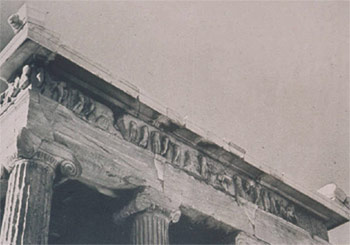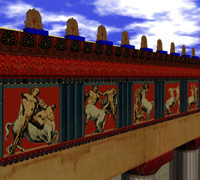Overview
Decoration
Greek temples were often richly decorated with paint, ornamentation, and sculpture. For example, the apex of the pediments and their corners would have been topped with ornate gold decoration (acroteria). Even the cult statue would have been painted and decorated with gold, silver, and ivory trimmings. Occasionally cult statues also had sculptural decoration on their base and even on the body of the god(dess).
Furthermore, any open area on the Greek temple was liable to be decorated with sculptures, although on less ornate temples, such areas might only be painted or even left blank.
In the Doric order the frieze is divided by a series of triglyphs into square areas known as metopes.

+ enlarge
In the Ionic order the frieze is continuous.

The pediments in both the Doric and Ionic order also offered considerable challenges to an artist.
Consider this pedimental sculpture group from the Temple of Aphaia at Aegina (6th century BCE). How does the artist respond to the challenges posed by the triangular form?

+ enlarge
 Surviving Greek temples stand out from the landscape with their clean, white marble lines. This unadorned style has been faithfully copied in many neoclassical buildings in the modern age. It is something of a surprise, then, to realize that Greek temples were extravagant in their placing of gold and silver objects to the top and corners of the pediment. In addition, the temples and their sculptures were covered in black, red, blue, and gold paint, creating a somewhat different picture to the bleached, pristine, white marble as this picture to the right indicates (click on the picture for more images from the Parthenon).
Surviving Greek temples stand out from the landscape with their clean, white marble lines. This unadorned style has been faithfully copied in many neoclassical buildings in the modern age. It is something of a surprise, then, to realize that Greek temples were extravagant in their placing of gold and silver objects to the top and corners of the pediment. In addition, the temples and their sculptures were covered in black, red, blue, and gold paint, creating a somewhat different picture to the bleached, pristine, white marble as this picture to the right indicates (click on the picture for more images from the Parthenon).
Overview: Architectural styles < Previous | Next > The Parthenon: Introduction